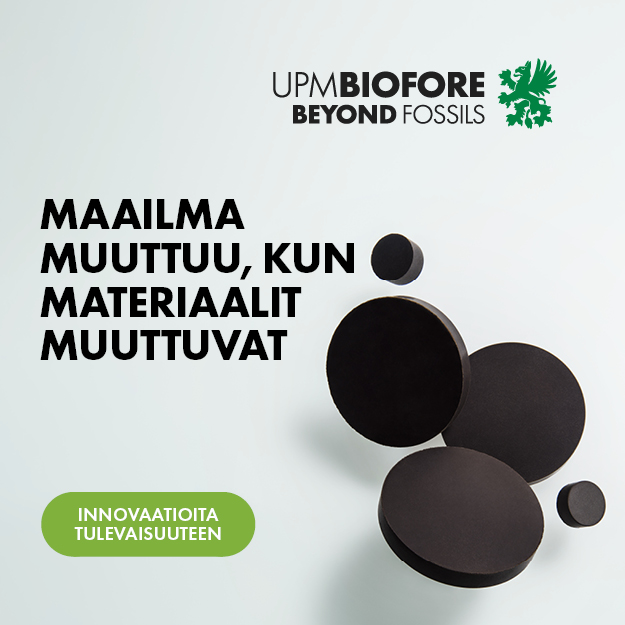
Forest industry production facilities improve their energy efficiency on a continuous basis. The solutions offered by equipment suppliers and process honing play an important role in achieving this.
The paper industry is said to be able to improve its efficiency and usability by one to two percentage points every year. Results are achieved through the development of automation and control systems and more efficient daily use.
And there is room for doing even better, given that equipment suppliers are working on three aspects by which to further improve the energy and raw materials efficiency of the forest industry.
The most traditional of these approaches is based on process design and implementation.
“It has to do with how an entire production facility is built and controlled and how its operation and maintenance is developed,” says Bertel Karlstedt, President of the pulp and energy business line at Valmet.
The second approach is based on equipment and machinery. Increasingly energy and production efficient soda recovery boilers are of interest to pulp industry equipment suppliers and customers alike.
The third approach seeks new dimensions from the diverse exploitation of biomass’s value chains. In addition to wood fibre, biomass is used to refine energy and chemicals.
New technology
Valmet has made significant progress in the commercialisation of biomass conversion technologies in the past few years.
Among other things, the company has developed lignin recovery technology, a pyrolysis technology that produces renewable biocrude oil from forest residue and a gas treatment that converts biomass into biomethane, to replace natural gas.
“Our concepts in the recovery of lignin —i.e. LignoBoost— and the pyrolysis technology have already been technically proven and delivered to the first customers,” says Karlstedt.
In LignoBoost, Valmet extracts, washes and dewaters lignin, which can replace fossil fuels in a pulp mill’s own processes or be further processed into biofuels and industrial chemicals.
“Creating a new value chain of lignin, formerly considered waste, interests all pulp mills,” remarks Karlstedt.
Europe’s biggest
For Metsä Fibre’s Äänekoski bioproduct mill, Valmet is delivering a soda recovery boiler, pulp drying line and a lime sludge reburning kiln.
In addition, Valmet is implementing a gasification plant in which tree bark is dried and gasified into a product gas to be used in the lime sludge reburning kiln.
The power of the soda recovery boiler which represents the latest generation of boilers can reach 7,200 tonnes of dried matter a day and, for the turbine, it produces steam at 260 megawatts.
The soda recovery boiler includes a number of qualities that increase the efficiency of electricity production, such as the patented method of recovering the heat from flue gas to the combustion air.
Regarding steam production, the increase in comparison to soda recovery boilers of the previous generation is as much as 10 per cent.
“The gasification technology and soda recovery boiler we’ve delivered maximise the exploitation of bioenergy, thanks to which the pulp mill will not have to use fossil fuels. In addition, the mill can sell 1.4 times as much electricity to the market than what it uses itself,” says Karlstedt.
Once completed, Metsä Fibre’s soda recovery boiler will be Europe’s biggest production unit of renewable energy.
More energy production, less consumption
The production design of the bioproduct mill under construction in Äänekoski is carried out by Sweco Finland, a consulting and engineering company that provides services for built environments and the industrial sector.
“We are responsible for pretty much everything outside of what the equipment suppliers take care of,” is how Sweco Industry’s process design engineer Niko Ruokolainen describes the division of tasks in the project.
There are three principal means by which to maximise the energy production of the bioproduct mill while increasing its energy efficiency: by maximising steam production and the pressure level, and by minimising steam use and the pressure level of the counterpressure steam.
“The key factor in maximising steam production is the development of the soda recovery boiler. The minimisation of steam use, on the other hand, is composed of several small improvements in the process aiming to reduce heat loss, for example, and the amount of water used. As far as possible, the process’s heating targets also use cheaper heat sources than main steam,” says Ruokolainen.
The end result of the energy introduced alongside black liquor is even more electricity.
Saving potential in water masses
In the future, the moving of water masses will be a key factor in the advancement of the energy efficiency of a pulp mill.
“A typical pulp mill implemented with the best available technology uses anywhere from 25 to 50 cubic metres of process water per tonne of produced pulp. The Äänekoski mill uses 10 cubic metres per tonne of produced pulp,” says Ruokolainen.
“Once you are able to reduce the water volume to a fourth of the usual level, for example, the energy used in its pumping and heating is reduced in almost equal proportion.”
Ruokolainen believes that future pulp projects will also be able to achieve savings through entirely new kinds of sub-processes and innovations.
Text Vesa Ville Mattila
Photo Valmet



